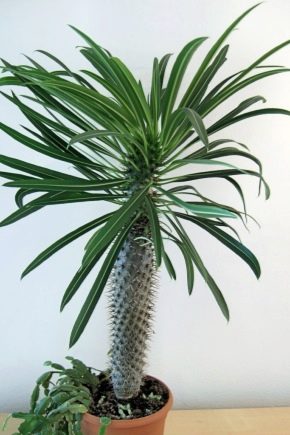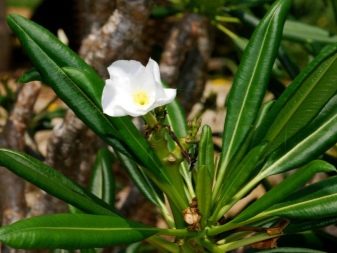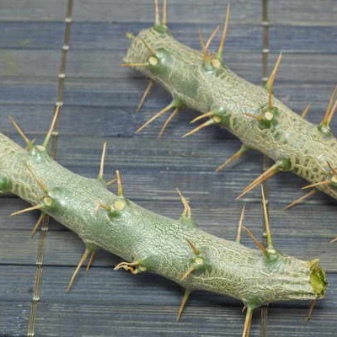Pachypodium: characteristics, types, cultivation

Unusual and interesting flowers are the perfect addition to any garden design, which is why many homeowners choose to grow pachypodiums. Despite the fact that this plant grows in the wild, there are many varieties that successfully take root at home. To grow such a flower on your own, you need to know the rules for caring for it.



Description
The pachypodium is an exotic plant that is grown for the original decor of landscape design. It belongs to the Kutrov family, translated from Greek, the name of the flower is translated as "thick leg". Most often, the pachypodium is found in Africa, Australia and Madagascar. It easily adapts to any climatic conditions and soil type. The flower can even grow in desert and arid areas, under these conditions it puts its roots deep into the ground to get moisture and nutrients.
The pachypodium has a different appearance, which depends on the growing conditions and external environmental factors. It can look like a tree (in this case, its height reaches 8 meters, the trunk diameter is 1.6 m) and an oval-shaped tall shrub that grows up to 4 m in length.When planted at home, the plant does not exceed height 1 m. In addition, all pachypodiums, regardless of varietal characteristics, have a fleshy gray trunk with a slight silvery sheen. The trunks of the plant have many thorns, which are only absent at the bend of the branches.


The trunk of the pachypodium is slightly thickened, this feature is due to the fact that in the wild, the plant needs to replenish water supplies during a drought. In addition to the thick trunk, the shrubs also have a well-developed system of underground roots; almost every variety also has a soft caudex. In addition, the plant receives moisture, and with the help of thorns, moisture from dew and fog is retained on them. The top of the trunk is covered with narrow thin leaves. The pachypodium acquires an attractive appearance during flowering, when it is covered with luxurious buds.
Important! An ornamental shrub is sometimes confused with euphorbia (milkweed), because when the trunk and branches are damaged, it secretes a white poisonous sap.


Types and varieties
The pachypodium is considered the most popular home-grown plant. Since it is too high, to decorate garden plots, flower growers prefer to choose dwarf varieties that reach a height of only 1 m (geya and bispinosum also look beautiful in gardens).

It is worth considering in more detail the most popular plant species.
Saunders
This plant is characterized by a thin spherical stem, which has a greenish-gray color. Over time, it can branch out, forming 3-4 shoots. There are few spikes on the surface of the trunk; as a rule, they are placed in heaps of 2-3 pieces. The leaves of this species are broad-lanceolate with sharp tips, they grow on shoots and are distinguished by a light glossy surface. The plant blooms beautifully, covered with single white, red or pink flowers.

Zhayi
An ornamental tree of this species outwardly resembles a cactus, it has a very thick and thorny trunk, which in the wild reaches a height of up to 8 m.At the top of the tree, leaves with sharp tips grow, they are pubescent and have a thickness of 3 cm. Young plants have gray thorns with black tips. During flowering, delicate flowers in the form of bells appear on the pachypodium, their petals are characterized by a snow-white color and a yellow spot in the middle.
If you grow a plant at home, then its height will not exceed 60 cm.


Lamer
This is a Madagascar palm tree, which is native to the island of Madagascar. The tree loves to grow on calcareous and stony soils, its height can be from 3 to 8 m. The trunk of this variety is thick and covered with protruding tubercles, each of which has 2-3 thorns. A dense rosette forms at the top of the stem of dark green foliage, the leaves of the plant are long (up to 9 cm). When it blooms, it is covered with creamy white buds with a pink tint, after flowering, fruits ripen oval and green in color.

Short-stemmed
The homeland of this species is also the island of Madagascar (central part). Its distinctive feature is considered to be a low, thorny stem. In a leafless state, the height of the shrub does not exceed 60 cm, its trunk is flat, succulent and tuberous. Outwardly, the short-stemmed pachypodium resembles a gray stone. An interesting look is given to the plant by yellow flowers ranging in diameter from 2 to 5 cm.


Succulent
This variety of pachypodium grows in South Africa, but it can often be found in the landscape design of many suburban areas. The tree has a pronounced trunk, at the base it is thickened, and its diameter can be up to 15 cm.The ground part of the plant is characterized by branching and fleshyness, its height does not exceed 90 cm.Young branches are covered with thorns and foliage up to 6 cm long.In summer, they bloom on formed bushes beautiful bright red flowers, they resemble bells.


Horombense
This variety is an unusual ornamental plant with a thick, low trunk. The leaves of this species are small, gray-green in color, they are narrow and form a luxurious rosette at the ends of the branches. The trunk of the tree is smooth, branches are located on it.
This plant is usually grown from seed, after sowing it begins to bloom in 2-4 years. In winter, the plant sheds foliage, a similar can be observed in summer if it lacks sunshine.

Dense-flowered
The main characteristic of this type of pachypodium is a fleshy stem, which exceeds 30 cm in diameter.The plant is excellent for growing in summer cottages, as it reaches a height of up to 90 cm.The leaves are placed at the very top of the trunk, they look special during the flowering period of the tree, original complementing yellow flowers with their bright green shade. This variety grows very slowly, and with improper care, the plant can shed its leaves.

Southern
This variety is excellent for growing in pots, although at home the crop can grow up to 1.2 m in length. The leaves of this pachypodium are very long, narrow and green. The trunk is chocolate-colored and smooth (without thorns). When a decorative tree blooms, huge pink flowers with a delicate aroma appear on it. The culture grows quite quickly and takes root easily, regardless of climatic conditions.


Rosette
This species has a special trunk shape. It outwardly resembles a huge vessel with several necks, from each of which bright green "sticks out". The surface of the stem is smooth, covered with thorns. The bush leaves form a lush rosette. The main advantages of the species are its compact size and low height (up to 1.5 m). The shrub blooms with yellow flowers that have the shape of bells, on each pedicel there are usually 3-4 buds.


Rutenberg
Under natural conditions, such a pachypodium can reach a height of up to 8 m, while growing at home, its growth is limited to 60 cm.The branches of the plant are short and covered with thorns, and bright green foliage is placed on them. The width of each leaf is 4 cm, the length is 15 cm. The plant blooms with large snow-white flowers, which are collected in an inflorescence of 3-4 pieces.


How to choose?
Before purchasing a particular variety of pachypodium, it is important to carefully study its characteristics and decide in advance on the landing site. For growing in houses and apartments, it is advisable to acquire dwarf species that do not exceed 40 cm in diameter. The height of the flower also plays a huge role - if it reaches 4 m or more, then the plant can only be planted in the garden.
When choosing planting material, preference should be given to healthy seedlings with a well-developed root system.


How to grow?
Almost all varieties of pachypodium have increased resistance to adverse climatic conditions, so caring for it at home is not difficult. The plant is undemanding to watering, is not afraid of direct sunlight and does not need regular feeding. Despite the fact that the content of the flower is simple, this does not mean that it does not need to be looked after at all.
In order for timely flowering to come, and the plant to please with its healthy appearance, when it leaves, you will still have to follow certain rules.


It is recommended to place a pot with a houseplant on a south-facing windowsill. If the apartment or house does not have south-facing windows, then it is placed in the east direction. It should be noted that an ornamental shrub can grow well in partial shade, the only thing is that under such conditions it will begin to lose its beauty and its shoots will become elongated.
The flower can easily adapt to both room and outdoor temperatures, in summer it should exceed + 30 ° C. If the plant grows in a room, then in the heat it can be taken out onto a balcony or loggia. When growing a shrub in a country house in the garden, it is important to choose a suitable place so that it is protected from drafts. In addition, in the fall, a street flower will have to be transplanted into a large pot, since the air temperature below + 15 ° C is considered critical for it. With hypothermia, the foliage begins to turn black on its crown and the softness of the trunk is noticed.


As for watering, the pachypodium loves moderate humidity, the excess of which can destroy the plant. Therefore, it is necessary to find the "golden mean" when growing, so that the soil is not too dry and wet. You need to water the flower with pre-settled water at room temperature.
Under natural conditions, ornamental shrubs grow on stony and sandy soils, which are poor in nutrients, so frequent fertilization can negatively affect their development at home. Experts recommend feeding the flower with small portions of trace elements in spring and summer, while it is strictly forbidden to use organic compounds and manure.
Many varieties of pachypodiums are characterized by slow growth, since their growth per year is no more than 5 cm. Thanks to this, the plant does not need to be repotted frequently. Young shrubs, as they grow, 1–2 years after planting, are moved to more spacious containers, which will be enough for them for another 3 years. It is advisable to transplant in early spring or autumn before the onset of cold weather.


It is best to buy soil for transplanting (planting) plants in stores, it should be intended only for succulents and cacti. If desired, the planting substrate can be prepared on your own by mixing brick chips with charcoal, sand and turf.
It is important that all components of the soil are treated with a solution of potassium permanganate.
Since this type of plant has needles on the trunk, then when transplanting it, you can face a huge problem. In order not to injure your hands and to protect yourself during further care of the flower, the thorns must be trimmed with sharp scissors.After that, the plant is carefully removed with an earthen lump from the old pot and carefully placed in a new container. Often, when planting at the pachypodium, roots can break, so you need to be careful with them.


Diseases and pests
An ornamental plant of this family is resistant to pests and diseases. If in the process of growth any problems happen to him, then improper care is considered to be the culprit. For example, a flower sheds leaves when it is cold or the soil was too wet. In addition, if the plant is watered with running water, then the leaves on its top first turn yellow, then turn black and fall off. In addition, the following can become the causes of the disease:
- drafts;
- a sharp change in air temperature day and night;
- frequent spraying of foliage;
- changing the location of the pot;
- uneven lighting.
As for pests, pachypodiums are most often attracted to settle thrips and spider mites. In order to prevent the active reproduction of these parasites, it is necessary to do timely prophylaxis in the form of spraying with medicinal preparations.


Reproduction
Pachypodiums reproduce in several ways, the most popular of which is cuttings. It is carried out as follows:
- at first they wait until the flower stretches out in growth;
- after that it is shortened;
- cuttings from the top are used for planting; it is best to perform a similar procedure in the spring, cutting off cuttings at least 15 cm long with a sharp tool;
- the places of the cuts on the mother plant and the cuttings are sprinkled with an activated angle, slightly soaking with a napkin;
- then prepare the container for planting, filling it with special soil;
- a drainage layer must be laid on the bottom of the pot;
- the stalk is planted in the ground, slightly compacting it, it is impossible to water on the first day after planting;
- the pot is placed in a place with moderate lighting, and the plant is regularly watered with warm, settled water.
Many growers also propagate the flower with lateral shoots (some varieties of the pachypodium have numerous lateral shoots). To do this, select in advance a branch, carefully separate it from the main trunk and treat the "wounds" with activated carbon. The transplant begins on the second day, the shoot is placed in a spacious pot. After that, it is important to observe how it takes root, the soil should not be allowed to dry out.


Plant propagation by seeds has also proven itself well, since in natural conditions it reproduces in this way. Of course, it is difficult to obtain seed at home (you need to wait until the flower reaches maturity), but it is easy to purchase it in specialized stores. For this, a more suitable variety of shrubs is selected and the soil is prepared for planting. It should be loose and light. The seeds are sown shallowly into damp ground, after which the container is covered with a lid and placed in a well-lit place.
Do not worry if the seedlings do not appear quickly, the seeds germinate very slowly. As soon as they hatch, you can open the container for airing, after a week the lid is completely removed.
During the growth of young plants, periodic watering is necessary. As a result, tiny sprouts will eventually turn into plush seedlings.


Florist tips
When the pachypodium is grown at home for the first time, it is important for the grower not only to follow all the rules in care, but also to know the varietal characteristics of the plant, since each variety has its own requirements. Novice gardeners can avoid many mistakes with simple recommendations from experts.
- To protect the root system of the flower from rot, and the leaves from falling off, the moisture level of the soil should be controlled. In addition, if the humidity is high, the trunk of the plant will look ugly (it will stretch out and acquire a soft structure).If the flower is not watered for a long time, then it will also begin to lose foliage.
- Do not water the plant with cold running water, this will lead to the fact that its young greenery will turn black and crumble. This is especially true in winter, when the flower needs to be watered only with warm water.

For information on how to transplant a pachypodium, see the next video.































The comment was sent successfully.